Arguably the most anticipated camera in Nikon's recent line up is the 36mp beast that is the D800. But it's not been without it's criticisms and sceptical response from some people. And if I'm honest, I was one of them! But, has handling the camera for myself changed that? In a word, YES.
Bare in mind, much like my recent D4 review, this was also with a pre-production model and so I was unable to take any images away with me. Also, Nikon only had a D800 available and no D800E or MB-D12 grip. Unfortunately after the recent robbery they've been reduced to just this one camera, the very same one that those of you who went to Focus On Imaging would have been playing with!
My own thoughts before I got to see the D800
I'll admit, I've not had 'that' much interest in the D800 since it's announcement and as such haven't followed the discussion on it as much as I have with the D4. Why? Three reasons (well, four-ish):
1) 36mp is a lot of resolution! I'm not a landscape or studio shooter, and I certainly don't remember the last time I had need for an image to be printed 100 feet wide. With no need for that resolution I wasn't prepared to accept what I thought would be the downsides, including...
1a) Noise. Granted high ISO is far from the be all and end all of image quality but having gone from a D3 to a D3s and soon a D4, I do have a bar set in my head for what I find acceptable, whether that's right or wrong. At 36mp, I had a big concern over how that will affect the noise in the D800.
2) It's slow. 4fps? For me and what I do, that sounds slow, very slow.
3) I don't like half size bodies. Full size pro bodies just feel better in the hand, it's a personal thing.
So, with that in mind, I headed off to Nikon HQ to see if my opinions would change for better or worse.
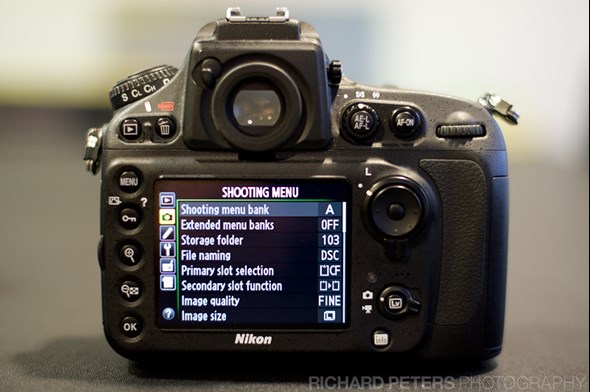
D800 menus
The basics
Just to get this out there now. There are of course going to be comparisons to the D4 because these are now the latest and greatest out the Nikon stable, and the D800 does feature the exact same focusing and 91k metering as the D4 and the same new larger rear LCD. But they are two entirely different products aimed mostly at different types of shooting styles.
On the D800:
There is USB3 for fast file transfer of those huge 76mb RAWs (or 212mb TIFFS) but there is no XQD.
The video does not support the 1:1 pixel matching mode of the D4 (although it still has clean HDMI out)
The buffer is smaller at roughly 12 RAW and 25 jpeg (with a Sandisk Extreme 60mb/s card)
It does not support the new WT-5 because there was simply not enough room to fit not just the port, but the electronics that go inside the camera, in to the smaller body.
The D800 uses the same battery as the D7000. It's rated at roughly 900 RAW files but one of Nikon's reps did a 1200 shot timelapse and the battery still showed 2/3 full. Of course when shooting a timelapse auto focus is off and the metering and white balance are fixed, so there is less draw on the battery but still, it's not bad.
The MB-D12 battery can accept the D4 battery
Unlike the D4, when in DX crop mode, the edge of the viewfinder is not masked out, instead a thicker black box appears in the centre of the viewfinder to show you the DX area.
And whilst I'm on the subject, I expect the D800 will also see the death of the D3x. With the exception of those who prefer the larger body, the D800 pretty much blows it clean out the water, and you'd have to REALLY like the larger pro body to justify buying what is essentially an inferior camera with a much higher price tag.
Ok, so that's some highlights, now on to a more detailed look at some key points.
Size and build
It's fair to say I went in to this meeting with Nikon already expecting to be disappointed. I'd read the D800 was a tad smaller than the D700 (which I never owned) and from the images and the way the D800 logo doesn't appear to have room to sit flat on the front of the camera I just had the impression this thing was barely going to be bigger than the D7000 - which I had brought along to compare. But literally from the second I picked it up, it felt solid and chunky and it sat in my hand not just nicely, but perfectly. It's safe to say it felt far more comfortable than any other ungripped body I've held in the past. Nikon have always been fantastic with the ergonomics of their cameras and the D800 is certainly no exception. It's safe to say all of my preconceptions about it's size and build went out the window within seconds of holding it. It's not as weather proof as the D4, but I was informed it's on par with the D700. I also noted the on/off switch is larger and flatter than on my D3s, with a slightly more solid feel to it. The shooting mode selector remains locked until a button press (unlike the D4's unlocked but half covered selector) but the whole thing just feels solid and robust. We also now have the familiar shutter button AND record button layout of the D4, but to my hands, the grip feels slightly less chunky than it's bigger brother, which to my small hands was actually a good thing. I have no doubt the grip will only improve on the excellent handling.
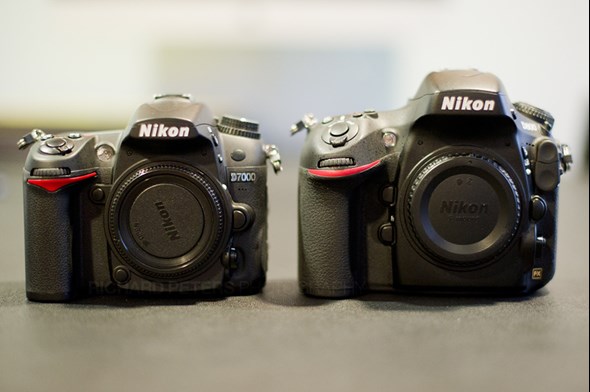
The D7000 and D800
Speed
The D800 is not initially designed to compete for camera bag space with sports and press photographers. It's aimed primarily at landscape, portrait and studio shooters who can take their time to get the shot just right. And so this camera is not a rapid shooter. I asked if it was a hardware or software limitation keeping the fps at 4 and it was confirmed it is a hardware limitation. When you think how much data is stored in those huge 36mp files, you can appreciate that. Of course adding the grip will get you an extra 2fps in DX crop mode, bringing you up to a more respectable 6fps. But again you have to remember, this is a whole new breed of camera. It's not aimed at the D4 high speed market and it's not, in theory, aimed at the D700 market - in fact, it could almost be argued that given who it is aimed at and the resolution on offer, we are spoilt with 4fps! Even given the speed limitations though, I can see some very practical uses for the D800 in wildlife situations as there are more than enough times when the subject isn't doing much other than sitting in glorious light. The lack of XQD was also in part due to the fact that this camera's typical shooting environment is expected to be a slow paced one (I'd have liked to see it included though, so as to streamline the different types of cards needing to be purchased).
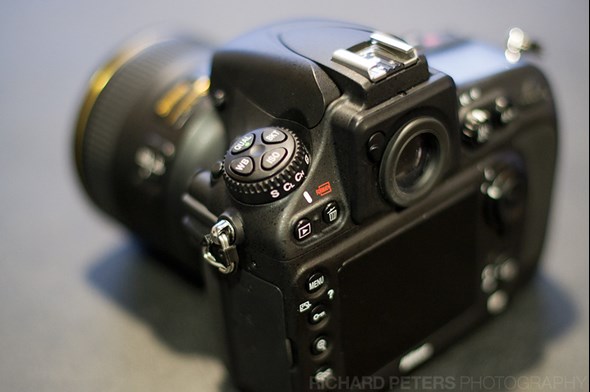
D800 controls
Image quality - high ISO better than the D700?
With a native range of 100-6400 (compared to 200-6400 on the D700) it's obvious the D800 will be compared to the D700, even though it't not the replacement for it. Now, clearly without doing proper tests to see just how the images and noise look from the D800, all I can do is tell you how it was perceived by me from taking shots and looking at the back of the camera, and relaying what information I was told. As I waited for Julian, my Nikon contact, to kindly get me a cup of tea I set about taking some test shots. To give you an idea, I was sat in a fairly well lit room at Nikon HQ, well lit by artificial light that is, and taking images around the room with the 85 1.4 AFS I was at times shooting around 1/160 at f3.5 with the ISO going up to 3200 depending on what I was pointing at. A quick look at the back of the camera and as I zoomed in on the image (it's weird how far in you can zoom with this much resolution!) one thing struck me, where is the noise? Even the black of a Nikon D4 brochure showed nothing. I was impressed. But confused. This was too good! So I had a quick look through the settings to discover the noise reduction was set to High. That explained it. So I switched it off and proceeded to take the same images again. Checking on the back of the camera this time had a different result. This time I was even more impressed! Because this time there was noise at 3200, but it was a lovely film grain like noise and it was very unobtrusive and refined, to the point that I had to go back to the noise reduction settings to make sure it was still off and not just reduced to medium or something by mistake. Now, you have to take this with a pinch of salt because it's not a fair and accurate test BUT it's a very good start, and once Julian returned and I explained my surprise at how well the camera was handling noise he explained to me that it has the edge over the D700 in the high ISO game (and as it shares the same sensor, the D3 its safe to say). Consider that for a second, here we have a camera that has better noise handling than what, not that long ago, was the best camera in the world for high ISO, but now we have it with 3x the amount of pixels. I can't begin to explain how much that one thing changed my opinion of this camera around!
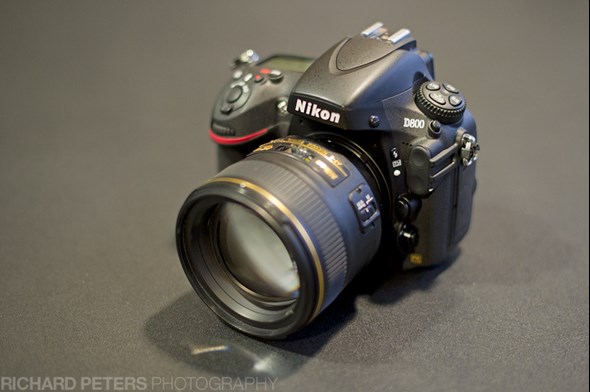
Nikon D800 with AFS 85mm f1.4 Lens
There has also been talk about how 36mp will make it harder to get sharp images due to the pixels being so tightly packed together. However, lets consider this (I'm keeping this review in simple terms, but just to put my geek hat on for a second), the D7000, which is a 16mp DX camera is generally well regarded for it's image quality, yet it has a pixel pitch of 4.78 microns, compared to 4.88 microns for the D800. What does that mean? Taking the geek hat off and explaining simply, the higher the pixel pitch number, the larger the pixels. The larger the pixels the more forgiving they are of camera movement and more light they gather (more light means better noise control). But let's keep it clear, your camera technique will need to be good to make the most out of the D800. I'm simply throwing the D7000 in as a reference so as not to let people think the D800 is going to be a totally uncontrollable monster because in theory, the D7000 is a harder camera to get good results from but is often praised but those who use it!
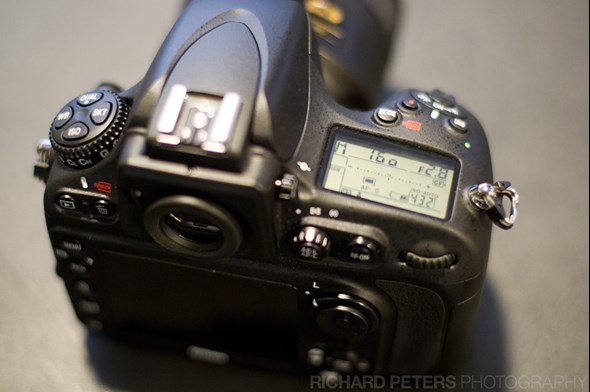
D800 top screen
What of the D800E and why is it more expensive?
So, the second incarnation of the D800 is the 'E' version. What that gives you is the exact same camera, but with the AA (anti-aliasing or Low Pass) filter removed. It transpires that in development Nikon tested the two versions side by side to work out which one to release, but the results were justifiably high enough to put both in to production. The first comments to surface after this was announced though were along the lines of 'why are we paying more money for less camera?', because essentially with no AA filter inside, that's one less part that needs to be paid for, right? Unfortunately, wrong. Without getting technical, for those that don't know, although Nikon have effectively removed the filter, they haven't literally just chucked it out. They've had to redesign it. There is still a filter in there, but the elements have been designed to counter the effects of the way the light is split as it passes through. So, you're actually paying more because you are paying for a specially redesigned filter and one that won't be produced at the same high levels as the one in the regular D800, because the 'E' variation will be more of a niche product. What that gives you though, is a sensor that is able to pick up more detail than the standard version.
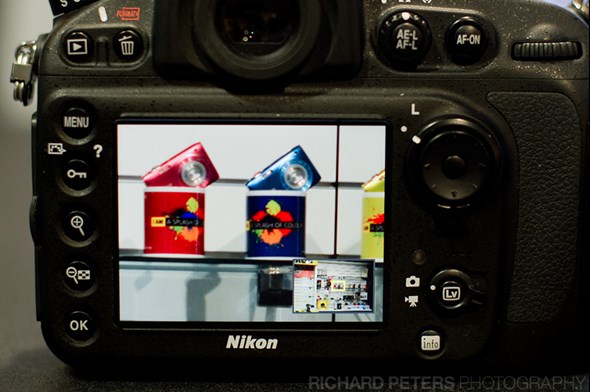
D800 review screen
So, D800 or D800E, what one to go for?
I'd probably ague that if you don't know which version is right for you, or what Moire is or how it's caused, then the regular D800 is the one to go for. Indeed Nikons owns strategy is that only selected retailers will be able to sell the D800E. And those retailers will each have at least one member of staff trained on how to handle moire, to advise ways to shoot round it, the possibility of getting it and how to reduce it, not just at the time of taking the shot but also with processing. This is a very smart move. There will be an awful lot of shooters out there that simply won't know any of this. That's nobodies fault, it's just the way it is as all other camera's with the AA filter reduce this without them ever having to worry. But with the D800E it' something they do need to be aware of. And so, limiting the ability to only being able to buy the camera from someone who can fully explain the potential negatives of the 'E' and how to work round them will absolutely help customers make an informed choice on which version to get without them feeling disappointed further down the line.
Of course Moire can be removed (or reduced) with editing, and Capture NX updates will improve tools for this. But it's worth pointing out that it could be a bigger problem for those of you who wan't to shoot film, so that is something worth keeping in mind. And it was also said that shooting in Jpeg with the 'E' is also not advised, as removal of moire will be far simpler with the tools available to RAW editors.
How big a difference will you notice between the regular and the 'E' in print quality?
Well, there will be a difference, but only once you get in to massive prints. I've already seen five foot wide prints from a humble 12mp D3s (which sounds awfully low resolution and old now!) that looks incredible, even when viewed at close range, so for the average consumer it could be argued you'd never make the most of the 'E' version and reap the benefits as you'll simply never print big enough to see the advantage of it over the regular version. But for those who need to print big on a regular basis for commercial work, and can work round the moire, then there's no doubt the 'E' will give you the ultimate in high resolution and detail!
So, my final thoughts now I'd played with the D800?
My preconceptions were wrong and I don't mind admitting it. Everything I expected to hate about the D800 I loved. It's solid in the hand, comfortable even without the grip and the image quality is beyond what I was expecting. More speed would always be welcome of course, but I understand who this camera is aimed at and I understand adapting it to my needs would come at some compromise, and I'm ok with that (plus there is still the option to drop to DX mode and get an extra 2fps with the grip). Sure 36mp is a LOT, and as I've said, not needed by the vast majority who will buy it. But that doesn't matter, it is here, it is high quality and it is in an all round nice package at a price point that to be honest, is nothing short of incredible! But remember, the cost of owning this camera doesn't stop at the camera itself, you are going to need a pretty powerful computer to edit the files once you start adding layers etc in Photoshop!
To summarise my thoughts on the D800 in one final sentence though...
...I'm now starting to regret not putting a pre-order in!
About the author
Richard Peters is a professional photographer based in London, whose main interest is wildlife and nature photography. As well as taking his own images, Richard has been on the judging panel for photography competitions for both the BBC and Nikon Europe. He blogs at http://www.richardpeters.co.uk/blog/

